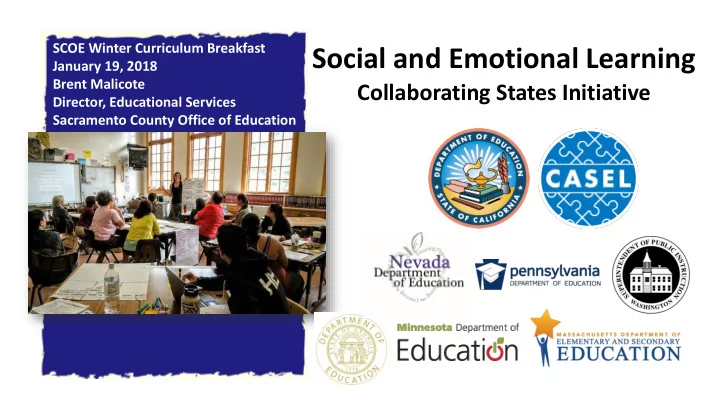

SCOE Winter Curriculum Breakfast Social and Emotional Learning January 19, 2018 Brent Malicote Collaborating States Initiative Director, Educational Services Sacramento County Office of Education
Objectives for Today Participants will: 1. work together to increase understanding of social and emotional learning (SEL) and why it is critical for student success; 2. build understanding of important SEL tools and resources; 3. build understanding of current state and national SEL efforts; and 4. build understanding of important research that underscore the importance of effective SEL implementation.
What is Social and Emotional Learning? Social and emotional learning (SEL) is the process through which children and adults acquire and effectively apply the knowledge, attitudes, and skills necessary to understand and manage emotions, set and achieve positive goals, feel and show empathy for others, establish and maintain positive relationships, and make responsible decisions. -The Collaborative for Academic, Social, and Emotional Learning (CASEL)
The California Team • Tom Adams – Deputy Superintendent of Public Instruction, Instruction Learning and Support Branch, California Department of Education (CDE) • Katie Brackenridge , Senior Director, Expanded Learning Time Initiatives, Partnership for Children and Youth • Linda Darling-Hammond , President, Learning Policy Institute • Michael Funk, Director, Expanded Learning Division, CDE • Erin Gabe l, Deputy Director, External and Governmental Affairs Office, First 5 California • Heather Hough , Executive Director, CORE-PACE Research Partnership • Mai Xi Lee, Social Emotional Learning Director, Sacramento City Unified School District • Brent Malicote – CASEL CSI Team Lead – Director, Educational Services, Sacramento County Office of Education • Christine Olmstead, Assistant Superintendent Instructional Services Division, Orange County Department of Education • Jennifer Peck – Senior Advisor to Tom Torlakson (State Superintendent of Public Instruction) • David Rattray , Executive Vice President, Education & Workforce Development, Los Angeles Chamber of Commerce • Jane Robb , Instructional Specialist, California Teachers Association • Ilene Straus , California State Board of Education Liaison to the Planning Group
SEL – Five Core Competencies • Impulse control • Stress management • Self-discipline • Self-motivation • Goal setting SELF- SELF- • Organizational skills AWARENESS MANAGEMENT Social and Emotional RESPONSIBLE Learning • SOCIAL Problem identification DECISION- (SEL) AWARENESS • Situation analysis MAKING • Perspective-taking • Problem-solving • Empathy • Evaluation • Appreciating diversity RELATIONSHIP • Reflection • Respect for others SKILLS • Ethical responsibility • Communication • Social engagement • Building relationships • Working cooperatively • Resolving conflicts • 5 Helping/Seeking help
Where does SEL fit in California? Local Control Funding Formula – 10 California Priorities Priority 1: Basic Services Priority 2: State Standards Priority 3: Parental Involvement Priority 4: Pupil Achievement Priority 5: Pupil Engagement Priority 6: School Climate Priority 7: Course Access Priority 8: Other Pupil Outcomes Priority 9: Expelled Pupils – COEs Only Priority 10: Foster Youth – COEs Only
A Continuum of Supports • Intra/Interpersonal Skills • Character Education • Deeper Learning • Mental Health Promotion • 21 st Century Skills • Violence Prevention • Life Skills • Bullying Prevention • Mindsets (Growth/Learning) • Drug Prevention • Grit • Civic Engagement • Self-Control • Multicultural Education • Self Discipline • Positive Youth Development • Social Problem Solving • Project-based Learning • Emotional Intelligence • Conditions for Learning • Restorative Practices • Climate/Culture • Service-learning 7
Students who receive SEL programing, compared with controls, perform … 9%ile Points Higher in Prosocial Behavior 9%ile Points Lower in Conduct Social and Problems Emotional 10%ile Points Learning Lower in Emotional Distress 11%ile Points Higher in Academic (Durlak, Weissberg, Dymnicki, Taylor, & Schellinger, Achievement 8 2011)
Teachers Believe SEL Benefits Students in School, Work, and Life (Bridgeland et al., 2013) • Students from all types of backgrounds, both 97% affluent and poor would benefit from learning SEL skills in school • Preparing students for the workforce 87% • Students becoming good citizens as adults 87% • Students ability to move successfully through 80% school and stay on track to graduate • Preparing students to get to/through college 78% 9
Recognizing an Active SEL Landscape 10
California’s Social and Emotional Learning Guiding Principles California’s Social and Emotional Learning Guiding Principles seek to empower local stakeholders to continue to advance SEL in ways that meet the needs of their specific contexts and populations. 11
Guiding Principle 1: Whole Child Education Take a systems approach to promoting student academic, social, and emotional learning, physical well-being, and college, career, and civic life readiness. Name SEL as not a “nice to have,” but a “must have to ensure student success in school, work, and community 12
Guiding Principle 2: Commit to Equity All students must have opportunities to build SEL skills and receive an assets-based educational experience that is personalized, culturally relevant and responsive, and intentionally addresses racism and implicit bias. Use practices that build on the existing strengths of students, educators, families, and communities. 13
Guiding Principle 3: Build Capacity Build the capacity of both students and adults through an intentional focus on relationship- centered learning environments and by offering research-based learning experiences that cultivate core social and emotional competencies. 14
Guiding Principle 4: Partner with Family and Community Maximize the resources of the entire school community, including expanded learning opportunities, early learning and care programs, and family and community partnerships, to advance SEL and student well-being. 15
Guiding Principle 5: Learn and Improve Adopt continuous improvement practices and use evidence to guide decision-making while aiming to enhance the quality of student social and emotional learning opportunities. Use data to inform improvement of instructional and school practices, not for accountability purposes. 16
Questions and a Call to Action Brent Malicote Director, Educational Services Sacramento County Office of Education bmalicote@scoe.net
Recommend
More recommend